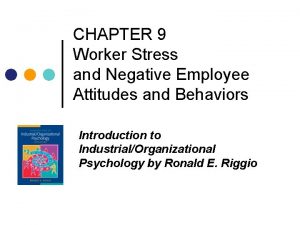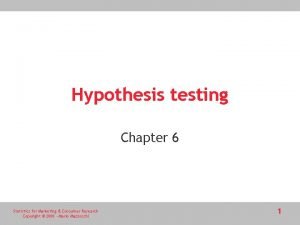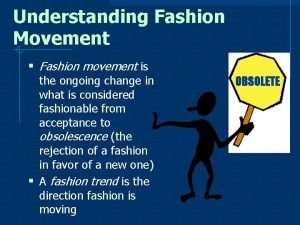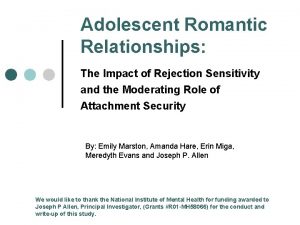Rejection Sensitivity Negative Attitudes in Romantic Relationships and


- Slides: 2

Rejection Sensitivity, Negative Attitudes in Romantic Relationships and Relationship Satisfaction Madeline Linn & Dr. David E. Szwedo James Madison University Introduction • Rejection Sensitivity consists of the intense feeling of anxiety and high concerns of rejection in novel social situations (Downey & Feldman, 1996). Rejection sensitivity in romantic relationships can impact the overall quality of the romantic relationship between partners. • • Negative relationship aspects include jealousy, anxiety, and avoidance. These factors play a role in relationships because these factors can cause negative outcomes in such relationships. Jealous emotions are observed in individuals with higher levels of rejection sensitivity. Similarly, an individual who has high levels of anxiety, will have lower rejection sensitivity and think that their partner dislikes them and does not want to be with them. Furthermore, individuals who are avoidant report low confidence in controlling negative emotions and strategies which correlates to lower levels of rejection sensitivity (Creasy & Hesson-Mc. Innis, 2001). The purpose of this study is to examine the effects of rejection sensitivity in relation to negative aspects in the relationship and how those factors impact the positive outcomes in a romantic relationship. Hypotheses • Higher levels of rejection sensitivity will predict higher levels of negative relationship attitudes—including higher levels of attachment anxiety, attachment avoidance, and jealousy of the romantic partner. • Teens with higher levels of rejection sensitivity will experience lower levels of satisfaction and positive characteristics in their romantic relationships. • Higher levels of rejection sensitivity and higher levels of negative relationship attitudes will interact to predict lower levels of positive romantic relationship quality Anxious and Avoidant Attachment (age 20— 22) Assessed using the Measurement of Adult Romantic Attachment (MAR). Measuring avoidance and anxiety in romantic relationships. Self-report measuring the levels that individuals display characteristics of either avoidant or anxious attachment styles within romantic relationships. Supportive Behavior Task (age 23— 25) Assessed quality of support within the relationship based on the teen’s perspective. Specific measures examined were engagement, self-disclosure, instrumental and emotional support, and interpretation. Network of Relationships inventory (age 23— 25) Assessed relationship with romantic partner or best friend. Variables examined represented positive qualities and consisted of companionship, aid, alliance with romantic partner; as well as, punishment as a negative quality. Results Correlations between primary variables are presented in Table 1 below. Correlations did not show significant relationships between variables and significance was only found in interactions. Furthermore, there were no significant findings in self-report measures. Significance was only observed in romantic partner report measures. Figure 1. Interaction between rejection sensitivity and anxiety predicting instrumental support given by the romantic partner to the teen. A similar pattern of results was observed between variables predicting reliable alliance as well. Regression equations examined positive and negative relationship aspects as well as their interaction, as predictors with rejection sensitivity (see Figures 1 -4). Analyses controlled for participant gender and family income. Regressions showed positive relationship between rejection sensitivity and negative relationship aspects predicting positive relationship qualities. Specifically, regression with rejection sensitivity and jealousy predicting punishment and self-disclosure was significant. Table 1. Univariate statistics and intercorrelations between primary constructs. * p <. 05, ** p <. 01, *** p <. 001 1. Gender Mean (SD) 1. 53 (0. 500) 1 2 3 4 5 6 7 8 9 10 11 12 13 14 ---- Method 2. Income Figure 3. Interaction between rejection sensitivity and total jealousy predicting punishment given by the romantic partner to the teen. -0. 11 3. Rejection sensitivity 8. 45 (3. 12) -0. 16* 0. 061 ---- 73. 57 (16. 96) 0. 22* -0. 066 -0. 014 ---- 5. Anxiety N = 184 50. 97 (22. 27) 0. 065 0. 14 0. 28*** Race/ethnicity 107 Caucasian 53 African American 24 Mixed/Other Income Median = $40, 000 - $59, 000 -0. 19* 0. 029 0. 22** 0. 051 0. 31*** ---- 7. Alliance 12. 00 (2. 73) -0. 037 0. 063 -0. 038 -0. 022 -0. 093 • Individuals with higher rejection sensitivity and higher negative relationship qualities could be displaying lower positive qualities due to their partner’s awareness of those negative qualities. The teen’s partner could also be overcompensating by giving the teen an extra sense of security and therefore displaying higher levels of positive relationship qualities. 0. 014 ---- 8. Instrumental Support 2. 56 (0. 89) -0. 22* 0. 33* 0, 17 0. 016 0. 13 -0. 035 0. 063 ---- 9. Interpretation Measures Rejection Sensitivity (age 20— 22) Assessed using Rejection Sensitivity Questionnaire (RSQ). A self-report measure of levels of rejection sensitivity including vignettes about themselves or another person. Jealousy (age 20— 22) Assessed using the Multidimensional Jealousy Scale (MJS). A self-report that measured cognitive, behavioral and emotional jealousy tendency of the individual within the romantic relationship. 47. 98 (21. 20) 3. 59 (0. 52) -0. 35** 0. 19 0. 17 0. 0047 0. 041 -0. 13 -0. 018 0. 59*** ---- 10. Aid 10. 49 (2. 37) -0. 14 0. 0020 0. 10 0. 0028 -0. 045 -0. 046 0. 17 0. 18 0. 13 ---- 11. Self-Disclosure 0. 18 (0. 38) -0. 098 -0. 099 -0. 062 -0. 15 -0. 18 0. 0011 -0. 066 -0. 22* -0. 13 • These results suggest the presence of a greater level of connectedness, within the bounds of the positive characteristics examined, within the romantic relationship between partners. Results indicate the importance of the role that rejection sensitivity plays in relationships and how it interacts with the different variables present in relationships as well. -0. 19 ---- 12. Engagement 2. 94 (0. 62) -0. 27** 0. 40*** 0. 21 0. 063 0. 30* 0. 048 0. 11 0. 75*** 0. 56*** 0. 14 -0. 10 ---- 13. Companionship 11. 74 (2. 13) -0. 078** 0. 21* 0. 19 -0. 097 0. 053 0. 13 0. 27* 0. 21* 0. 29* 0. 37** -0. 073 0. 34* ---- 14. Emotional Support 0. 55 (0. 70) -0. 063 0. 092 -0. 038 -0. 15 0. 021 -0. 18 0. 14 -0. 079 0. 054 -0. 016 0. 32* 0. 18 -0. 027 ---- 15. Punishment 4. 13 (1. 84) 0. 29* -0. 45*** -0. 27* 0. 17 -0. 092 0. 010 Figure 4. Interaction between rejection sensitivity and total jealousy predicting self-disclosure. Discussion 0. 25* ---- 6. Avoidance Gender 86 males 98 females 6. 10 (1. 96) ---- 4. Jealousy Participants Figure 2. Interaction between rejection sensitivity and avoidance predicting alliance between the romantic partner and the teen. A similar pattern of results was observed between variables predicting interpretation, aid, engagement, instrumental and emotional support, and companionship as well. -0. 16 -0. 28* -0. 25* -0. 18 -0. 12 -0. 39** -0. 34** -0. 16 • Future research could be conducted to further examine gender and its relationship with the present variables. Further examinations could also include the relationship between dependency on the present variables.

1. Gender Mean (SD) 1. 53 (0. 500) 1 2 3 4 5 6 7 8 9 10 11 12 13 14 ---2. Income 6. 10 (1. 96) -0. 11 ---- 3. Rejection sensitivity 8. 45 (3. 12) -0. 16* 0. 061 ---- 4. Jealousy 73. 57 (16. 96) 0. 22* -0. 066 -0. 014 ---- 5. Anxiety 50. 97 (22. 27) 0. 065 0. 14 0. 28*** 0. 25* ---- 6. Avoidance 47. 98 (21. 20) -0. 19* 0. 029 0. 22** 0. 051 0. 31*** ---- 7. Alliance 12. 00 (2. 73) -0. 037 0. 063 -0. 038 -0. 022 -0. 093 0. 014 ---- 8. Instrumental Support 2. 56 (0. 89) -0. 22* 0. 33* 0, 17 0. 016 0. 13 -0. 035 0. 063 ---- 9. Interpretation 3. 59 (0. 52) -0. 35** 0. 19 0. 17 0. 0047 0. 041 -0. 13 -0. 018 0. 59*** ---- 10. Aid 10. 49 (2. 37) -0. 14 0. 0020 0. 10 0. 0028 -0. 045 -0. 046 0. 17 0. 18 0. 13 ---- 11. Self-Disclosure 0. 18 (0. 38) -0. 098 -0. 099 -0. 062 -0. 15 -0. 18 0. 0011 -0. 066 -0. 22* -0. 13 -0. 19 ---- 12. Engagement 2. 94 (0. 62) -0. 27** 0. 40*** 0. 21 0. 063 0. 30* 0. 048 0. 11 0. 75*** 0. 56*** 0. 14 -0. 10 ---- 13. Companionship 11. 74 (2. 13) -0. 078** 0. 21* 0. 19 -0. 097 0. 053 0. 13 0. 27* 0. 21* 0. 29* 0. 37** -0. 073 0. 34* ---- 14. Emotional Support 0. 55 (0. 70) -0. 063 0. 092 -0. 038 -0. 15 0. 021 -0. 18 0. 14 -0. 079 0. 054 -0. 016 0. 32* 0. 18 -0. 027 ---- 15. Punishment 4. 13 (1. 84) 0. 29* -0. 45*** -0. 27* 0. 17 -0. 092 0. 010 -0. 16 -0. 28* -0. 25* -0. 18 -0. 12 -0. 39** -0. 34** -0. 16



